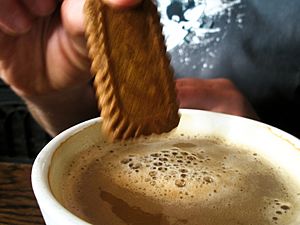Dunking (biscuit) facts for kids
To dunk or dip food means to quickly put it into a drink. People often dunk biscuits or other baked goods into tea, coffee, or milk. Dunking helps release more flavor from sweet treats. It does this by dissolving the sugars. It also makes the food softer. If a biscuit has chocolate, dunking can melt it a little, making it taste even richer.
Dunking is a popular way to enjoy biscuits in many countries. In Australia, a fun way to dunk is called the "Tim Tam Slam". This involves biting off opposite corners of a Tim Tam biscuit, using it like a straw to suck a drink through, and then quickly eating the softened biscuit.
Contents
The History of Dunking
Dunking food has been around for a very long time!
Ancient Beginnings
The ancient Romans were some of the first to dunk. They would soften their hard, twice-baked wafers (called bis coctum) in wine.
In the 16th century, sailors in the Royal Navy had very hard biscuits called "hardtack". These were so tough that sailors would dunk them in beer to make them soft enough to eat. This helped them enjoy their food on long voyages.
Modern Dunking Around the World
Today, dunking is a common custom everywhere:
- In the United Kingdom, the McVitie's chocolate digestive is a favorite for dunking in tea.
- In the United States, Oreo cookies are often dunked in milk. The famous Dunkin' Donuts chain even got its name from people dunking their doughnuts into coffee!
- In South Africa and India, rusks are popular for dunking in both tea and coffee.
- In the Netherlands, people often place a stroopwafel on top of a hot cup of tea or coffee for a few minutes. This melts the caramel inside before they dunk it.
- In Nigeria, bread is commonly dunked in tea or coffee.
- In Australia and New Zealand, gingernut biscuits (especially Arnotts brand) are often dunked in tea or coffee.
Etiquette and Style of Dunking
While dunking is fun, different cultures and times have had different ideas about whether it's polite.
British Customs
In Great Britain, dunking became popular with afternoon tea in the 19th century. At first, some people in high society thought dunking was rude or only for children and the working class. However, it's said that Queen Victoria herself enjoyed dunking her biscuits! In 2007, a tea room in Brighton, England, even banned dunking, showing how opinions can differ.
Marketing in the US
In the United States, dunking became a marketing tool in the 1930s. Doughnut sellers created the National Dunking Association. This group encouraged people to follow "rules for dunking" and helped promote their products.
The Science Behind Dunking
Dunking isn't just about taste; there's some cool science involved!
How Liquids Get In
When you dunk a biscuit, liquid gets drawn into it. This happens because biscuits have tiny holes, making them porous. The liquid is pulled into these small spaces by something called capillary action. This is the same force that helps plants draw water up their stems. The surface tension of the drink (how much its molecules stick together) also plays a role in how the liquid moves into the biscuit.
Scientists and Dunking
Physicist Len Fisher from the University of Bristol has talked about the science of dunking. He wanted to make physics more interesting and fun for everyone. He was surprised by how much attention his "National Biscuit Dunking Day" research got!
In 2012, famous English chef Heston Blumenthal also looked into dunking. He found that dunking chocolate biscuits really does make them taste better. He explained that when the chocolate melts a bit, it creates a smooth, velvety texture, which adds to the delicious flavor.


